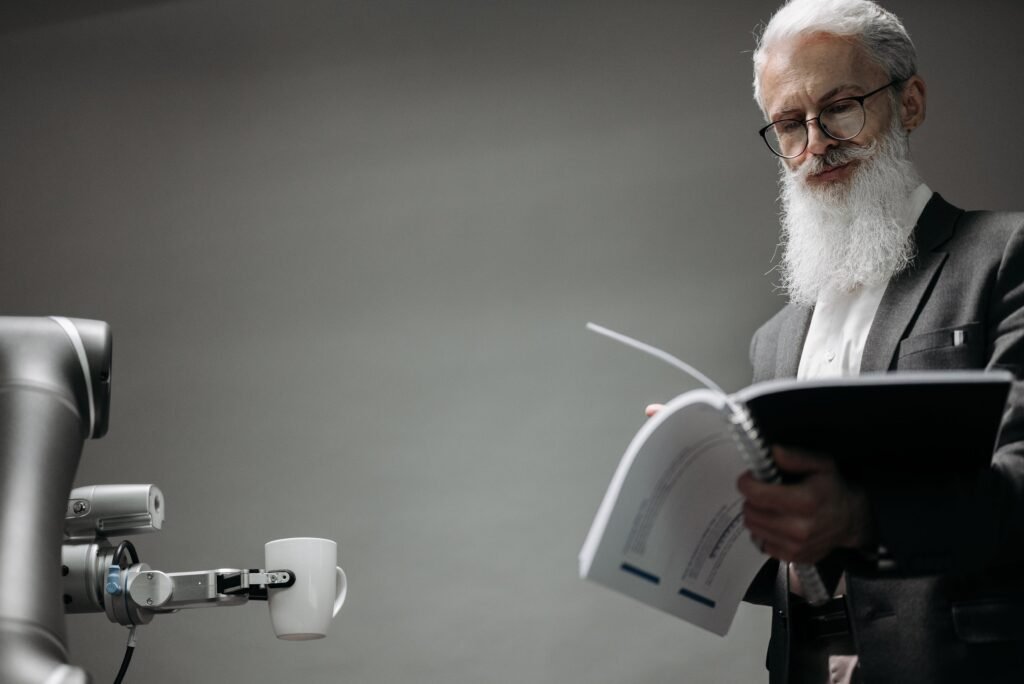Are you curious about the world of artificial intelligence and its various forms? Let us introduce you to the concept of weak artificial intelligence. In this article, we will explore what weak artificial intelligence is, its applications, and how it differs from strong AI. So, get ready to embark on a fascinating journey into the realm of AI, where machines possess human-like intelligence but with certain limitations. Whether you’re a tech enthusiast or simply intrigued by the power of AI, this article will provide you with a solid understanding of weak artificial intelligence. So, let’s dive in!

What Is Weak Artificial Intelligence
Definition of Weak Artificial Intelligence
Weak Artificial Intelligence, also known as Narrow AI, refers to a type of artificial intelligence that is designed to perform specific tasks or functions. Unlike its counterpart, Strong Artificial Intelligence, Weak AI focuses on solving specific problems and lacks the ability to possess human-like general intelligence. Instead of aiming to replicate human cognition, Weak AI is developed to excel in defined areas, utilizing predefined algorithms and relying on human input.
Comparison with Strong Artificial Intelligence
In contrast to Weak AI, Strong Artificial Intelligence aims to replicate human cognitive abilities, including problem-solving, learning, and consciousness. While Weak AI is designed with a narrow focus and limited scope, Strong AI possesses the potential to exhibit general intelligence and can perform tasks beyond a predefined set. This fundamental distinction between Weak AI and Strong AI lies in their capabilities and scope, as well as the level of autonomy and decision-making exhibited by each.
Examples of Weak Artificial Intelligence
Weak AI finds its application in various domains, showcasing its specialized capabilities in specific tasks. Some examples of Weak AI include:
Virtual Personal Assistants
Virtual personal assistants, such as Apple’s Siri and Amazon’s Alexa, are prime examples of Weak AI. These intelligent chatbots are built to understand and respond to user inquiries, perform tasks like setting reminders, sending messages, or even ordering products online. Although they are proficient in voice recognition and natural language processing, their abilities are limited to their predefined functions.
Recommendation Systems
Recommendation systems have become increasingly prevalent in today’s digital landscape. These systems employ Weak AI algorithms to analyze user behavior, preferences, and patterns to suggest personalized content, such as product recommendations on e-commerce platforms or movie suggestions on streaming services. While they excel at providing tailored suggestions, they lack human-like contextual understanding and may occasionally generate inaccurate recommendations.
Automatic Speech Recognition
Automatic Speech Recognition (ASR) is another prominent application of Weak AI. ASR technology is employed in virtual voice assistants, transcription services, and even call center automation. It allows for the conversion of spoken language into written text, enabling machines to understand and interpret human speech. Although ASR has made significant advancements in accuracy and efficiency, its limitations persist in scenarios with heavy accents or noisy environments.
Natural Language Processing
Natural Language Processing (NLP) is a subfield of Weak AI that focuses on enabling machines to understand, interpret, and generate human language. NLP is employed in various applications, including language translation, sentiment analysis, and chatbots. While NLP algorithms can comprehend and process language patterns to a certain extent, they often fall short in grasping the contextual nuances and intricacies of human communication.
Image and Object Recognition
Image and Object Recognition is an area where Weak AI has made remarkable strides. It involves algorithms that enable machines to identify and analyze visual content, ranging from facial recognition to object detection in images. Weak AI-driven systems are utilized in tasks like self-driving cars, security surveillance, and medical diagnostics. However, these systems still face challenges in accurately recognizing complex images or adapting to varying environmental conditions.
Introduction to Artificial Intelligence
Defining AI
Artificial Intelligence is a branch of computer science focused on developing intelligent machines that can simulate human-like behavior and perform tasks that would generally require human intelligence. AI encompasses both Weak AI and Strong AI, as well as other subfields, such as Machine Learning and Deep Learning. The ultimate goal of AI is to create machines capable of executing complex tasks, learning from experience, and exhibiting behaviors similar to those of humans.
Goals of AI
The primary objectives of AI are to create systems that can automate tasks, assist humans in decision-making, and solve complex problems more efficiently. By emulating human cognitive abilities, AI strives to enhance various sectors, including healthcare, transportation, finance, and entertainment. The overarching goal is to develop intelligent machines that can augment human capabilities and improve productivity while delivering accurate and consistent results.
Applications of AI
AI has found applications in a wide range of industries and sectors. In healthcare, AI is utilized for medical image analysis, drug discovery, and personalized treatment plans. In transportation, AI powers self-driving cars, traffic optimization systems, and predictive maintenance for vehicles. The finance industry benefits from AI through fraud detection, algorithmic trading, and customer service chatbots. Even entertainment platforms employ AI for content recommendations, gaming simulations, and virtual reality experiences.
Types of AI
Within the broad field of AI, there are two primary classifications: Weak AI and Strong AI. Weak AI, as discussed earlier, focuses on narrow tasks and lacks general intelligence. Strong AI, on the other hand, aims to replicate human cognitive abilities and possesses the potential for self-awareness and autonomous decision-making. Other branches of AI include Machine Learning, which involves developing algorithms that allow machines to learn from data, and Deep Learning, a subfield of Machine Learning that utilizes neural networks to process complex data.
Understanding Weak AI
AI that Specializes in Narrow Tasks
Weak AI is designed to excel in specific tasks, with a limited scope of functionality. These tasks can include natural language processing, image recognition, or recommendation systems. By focusing on narrow areas, Weak AI can deliver efficient and accurate results within those defined parameters. However, it cannot extend its capabilities beyond the tasks it has been programmed for.
Reliance on Predefined Algorithms
Weak AI relies on predefined algorithms to perform its functions. These algorithms are created by developers and are responsible for guiding the AI system’s behavior in specific scenarios. The behavior and decision-making of Weak AI are limited to the algorithms it has been programmed with. If faced with a situation that deviates from those predefined scenarios, Weak AI may struggle to provide satisfactory responses or solutions.
Lack of General Intelligence
One of the fundamental characteristics of Weak AI is its lack of general intelligence. While it may exhibit proficiency in its specialized tasks, Weak AI cannot possess the comprehensive understanding or adaptability of human intelligence. It lacks the ability to learn from new experiences, generalize knowledge across different domains, or engage in creative thinking. Weak AI operates within the boundaries of its programming and predefined algorithms.
Dependence on Human Input
Weak AI relies on human input for its continued functioning and improvement. Developers and operators play a crucial role in programming and training Weak AI systems, providing them with the necessary data and instructions. Regular human intervention is required to refine the algorithms, address any limitations or errors, and update the AI system to tackle new challenges. Without ongoing human input, Weak AI cannot operate effectively or evolve.
Capabilities and Limitations of Weak AI
Efficient and Accurate in Specific Tasks
Weak AI demonstrates high efficiency and accuracy within the predefined tasks it is designed to handle. By focusing on narrow areas, Weak AI can excel in performing functions that may be time-consuming or challenging for humans. Its specialized algorithms and processing capabilities allow for quick and accurate data analysis, decision-making, and automation in various domains.
Inability to Adapt or Learn Beyond Programming
While Weak AI performs specific tasks excellently, it lacks the ability to adapt or learn beyond its programming. Unlike Strong AI, which can learn and generalize from experiences, Weak AI cannot acquire new knowledge independently. It is entirely reliant on predefined algorithms and human intervention for any updates or modifications. As a result, Weak AI may struggle to handle situations outside its predefined parameters or encounter difficulties in understanding novel scenarios.
Restricted Contextual Understanding
Weak AI often struggles with contextual understanding, which limits its ability to comprehend complex human interactions or requirements. While it can process language or visual data, Weak AI might fail to capture the context or interplay of nuanced factors. This limitation can lead to misinterpretations, erroneous responses, or inaccurate recommendations. Human oversight and intervention are necessary to ensure that Weak AI systems operate within the desired context and produce satisfactory outcomes.
Necessity of Clearly Defined Inputs
To perform optimally, Weak AI relies on clearly defined inputs and accurate data. The accuracy and reliability of its outputs are highly dependent on the quality of the input provided. In situations where the inputs are ambiguous or incomplete, Weak AI may produce suboptimal or incorrect results. It is crucial to ensure that the algorithms and data fed into a Weak AI system are carefully curated and regularly evaluated to minimize the potential for errors or biases.

Narrow AI versus Weak AI
Differentiating Narrow AI and Weak AI
While the terms “Narrow AI” and “Weak AI” are often used interchangeably, there is a subtle difference between them. Narrow AI refers to AI systems that excel in specific tasks, precisely addressing predefined problems. In contrast, Weak AI encompasses both the technological concept of narrow focus and the philosophical distinction from Strong AI. Essentially, Weak AI is a broader term that encompasses the limitations and characteristics associated with narrow-focused AI systems.
Narrow AI’s Specialization in Specific Tasks
Narrow AI systems are primarily designed to specialize in specific tasks, demonstrating proficiency and accuracy within those defined areas. These systems optimize their performance through specialized algorithms and training data, making them highly efficient within their narrow scope. However, their abilities are limited to those specific tasks, and they lack the general intelligence and autonomy associated with Strong AI.
Weak AI’s Less Autonomous and Advanced Capabilities
Weak AI, while including narrow-focused AI systems, also extends to the overarching concept of limited intelligence and lack of human-like cognitive abilities. Weak AI possesses less advanced capabilities compared to Strong AI, focusing on specific functions and relying on predefined algorithms and human intervention for operation and improvement. It exhibits less autonomy in decision-making and lacks the potential for self-awareness and problem-solving beyond its given parameters.
Understanding Strong AI
AI that Mimics Human Cognitive Abilities
Strong Artificial Intelligence aims to emulate human cognitive abilities by developing systems capable of human-like reasoning, learning, and problem-solving. Strong AI aspires to create machines that possess general intelligence, enabling them to understand and pursue tasks beyond narrow bounds. This type of AI strives to replicate human consciousness and cognitive processes, considering factors such as self-awareness and subjective experiences.
General Intelligence and Problem Solving
The hallmark of Strong AI lies in its ability to exhibit general intelligence, allowing machines to excel in a wide range of tasks and adapt to new situations. Strong AI systems can generalize from experiences and apply acquired knowledge in novel contexts. They possess problem-solving capabilities, creative thinking, and the potential to learn independently, leading to ongoing improvement and adaptation to evolving circumstances.
Self-awareness and Consciousness
Among the distinguishing features of Strong AI is the potential for self-awareness and consciousness. These systems have the ability to perceive and understand their own existence, engage in introspection, and recognize their own mental states. While the realization of self-awareness in AI remains a deeply debated topic, the objective of Strong AI is to create machines that possess a heightened sense of self and consciousness.
Autonomous Decision-making
Strong AI systems have the potential for autonomous decision-making, which sets them apart from their Weak AI counterparts. By simulating human-like cognition, Strong AI can make informed judgments, evaluate complex scenarios, and derive decisions based on reasoning and comprehension. It can handle unstructured or ambiguous tasks, adapt to changing conditions, and exhibit a level of autonomous agency in problem-solving and decision-making processes.

Image and Object Recognition
Understanding Image Recognition
Image Recognition is a critical application of Weak AI, utilizing algorithms to identify, analyze, and interpret visual content. This involves training an AI model to recognize specific patterns, features, or objects within images. Image Recognition leverages techniques such as deep learning and convolutional neural networks to extract meaningful information from images and classify them into predefined categories.
Applications of Image Recognition
Image Recognition has immense practical applications across various fields. In healthcare, it aids in diagnosing diseases, detecting anomalies in medical images, and assisting in surgical procedures. Industries like retail benefit from image recognition in inventory management, image-based search, and quality control. Security systems utilize image recognition for facial recognition, access control, and surveillance. Overall, image recognition contributes to automation, efficiency, and accuracy in numerous domains.
Object Detection and Classification
Within the realm of image recognition lies the crucial task of object detection and classification. AI algorithms are trained to identify and locate specific objects within images, providing valuable information for various applications. Object detection plays a vital role in autonomous vehicles, enabling them to detect pedestrians, traffic signs, and obstacles. It also finds applications in robotics, video surveillance, and augmented reality, enhancing the overall perception and understanding of the environment.
Challenges and Advancements
While image recognition has made significant progress, it still faces challenges. Recognizing complex or abstract objects accurately can prove demanding, as well as dealing with variations in lighting, perspective, and scale. Another challenge is ensuring fairness and mitigating biases within image recognition systems. Researchers continue to explore cutting-edge advancements like deep learning architectures, transfer learning, and semantic segmentation to overcome these challenges and further improve the accuracy and robustness of image recognition systems.
In conclusion, Weak Artificial Intelligence, or Narrow AI, is focused on excelling in specific tasks and lacks the comprehensive general intelligence of Strong AI. Weak AI showcases its capabilities through various applications such as virtual personal assistants, recommendation systems, automatic speech recognition, natural language processing, and image and object recognition. While Weak AI is limited in its context understanding, adaptability, and autonomous decision-making, it demonstrates high efficiency and accuracy within narrowly defined parameters. As AI continues to advance, the interplay between Weak AI and Strong AI will shape the future of artificial intelligence, enabling transformative solutions across diverse industries.






